Small Business Video Marketing Your Guide to Growth



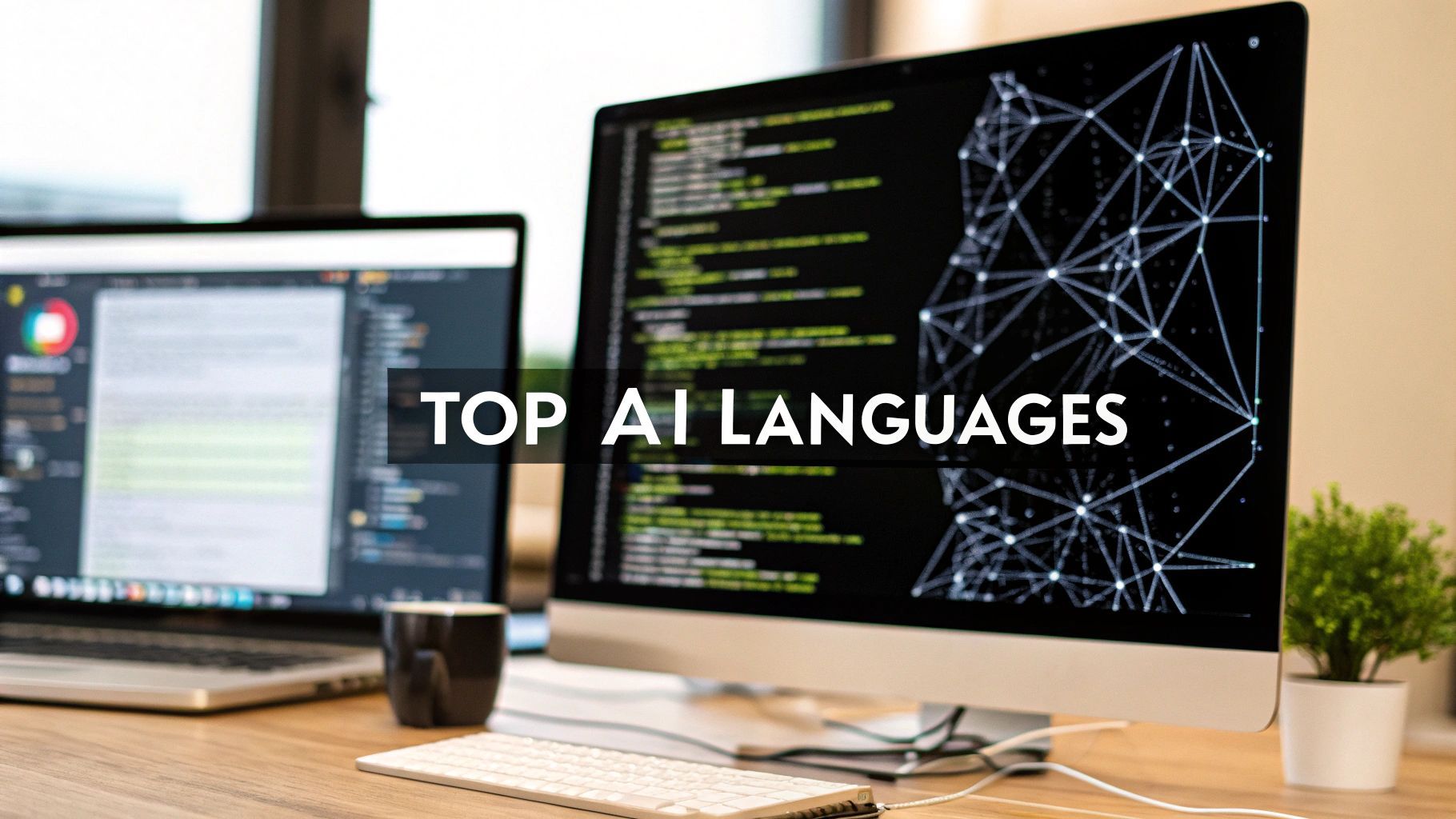
Discover the 7 best AI programming languages of 2025. Compare Python, Julia, MATLAB & more to find the perfect language for your next AI project.
Choosing the right tool for the job is half the battle, and in the world of artificial intelligence, your programming language is your ultimate weapon. It's the difference between a clunky prototype that chugs along and a lightning-fast model that feels like magic. But with a dizzying array of options, how do you pick a winner? Are you building a number-crunching behemoth that demands raw, unadulterated speed, or a creative, data-driven application that needs a vast ecosystem of pre-built libraries?
This isn't just another generic list. We're cutting through the noise to give you a definitive guide to the best AI programming languages and platforms for 2025. We will dive deep into the specific strengths, hidden weaknesses, and ideal project scenarios for each contender. Forget the guesswork; this is your practical roadmap.
Inside, you'll find a detailed breakdown of each option, complete with direct links to get started and screenshots to guide you. We're comparing everything from core features and essential libraries to performance benchmarks, helping you find the perfect language to power your next AI masterpiece. Let's find the right fit for your vision.
If the world of AI programming languages were a heavyweight boxing match, Python would be the undisputed champion, holding all the belts and rocking a victory robe made of pure data. Its claim to fame is a one-two punch of simplicity and power. The syntax is so clean and readable, it feels less like coding and more like writing a set of polite, firm instructions for your computer to follow. This low barrier to entry makes it one of the best AI programming languages for beginners and a rapid prototyping tool for seasoned experts.
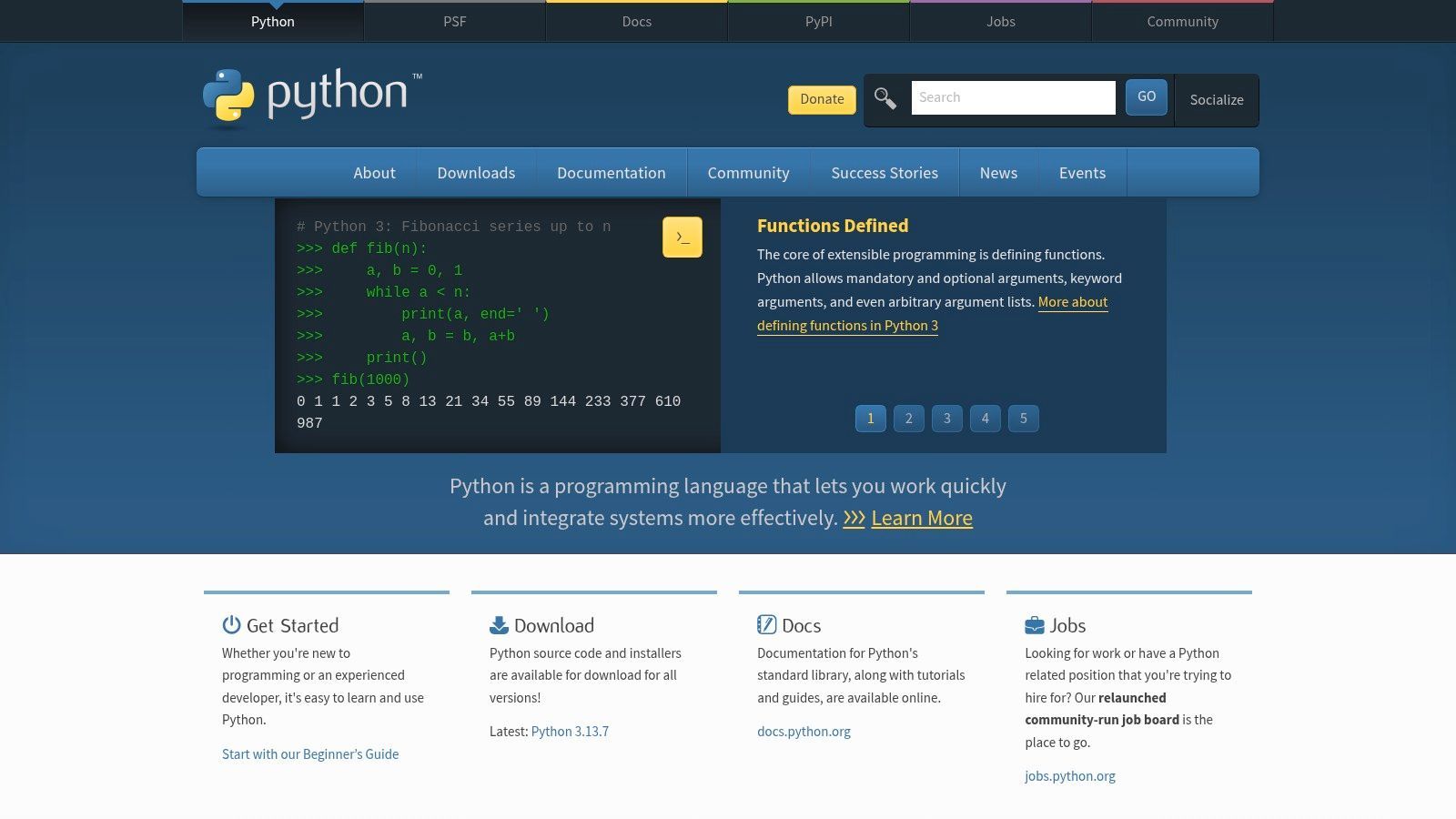
The official hub, python.org, is your starting line. It’s not just a download page; it’s a launchpad. You can grab the latest stable builds for any OS completely free of charge. This is a no-frills, get-what-you-need experience. You won't find flashy UI or bundled IDEs, just verified, secure installers.
Python's real superpower isn't the language itself, but its colossal community and the ecosystem it has built. Think of it as a workshop where every tool you could possibly need for an AI project is already on the shelf, free to use.
Data Wrangling: Got messy data? Pandas and NumPy are the dynamic duo for cleaning, manipulating, and preparing datasets for training. Machine Learning: Scikit-learn offers a plug-and-play toolkit for classic ML algorithms like regression, clustering, and classification. Deep Learning: For the heavy-duty neural network stuff, you have titans like TensorFlow and PyTorch, both with Python as their primary interface.
For those looking to delve deeper into Python's specific applications in AI, exploring further resources like a modern guide to Python AI coding can be invaluable.
| Pros | Cons |
|---|---|
| Zero-cost and official; get verified, secure downloads directly from the source. | DIY setup; users must manually install packages and configure their environment. |
| Massive AI/ML ecosystem; unparalleled library support for any task. | No direct commercial support; relies on community forums or third-party vendors for help. |
This DIY approach is a double-edged sword. While it gives you total control, it also means you’re the system administrator. But for the sheer power and flexibility it offers, Python remains the top contender in the AI ring.
If Python is the heavyweight champion, Julia is the nimble, lightning-fast contender built for pure speed. It enters the ring with a singular mission: to solve the "two-language problem," where researchers prototype in a slow language like Python but rewrite in a fast one like C++ for production. Julia combines the easy syntax of a high-level language with the raw performance of a low-level one, making it one of the best AI programming languages for performance-critical tasks.
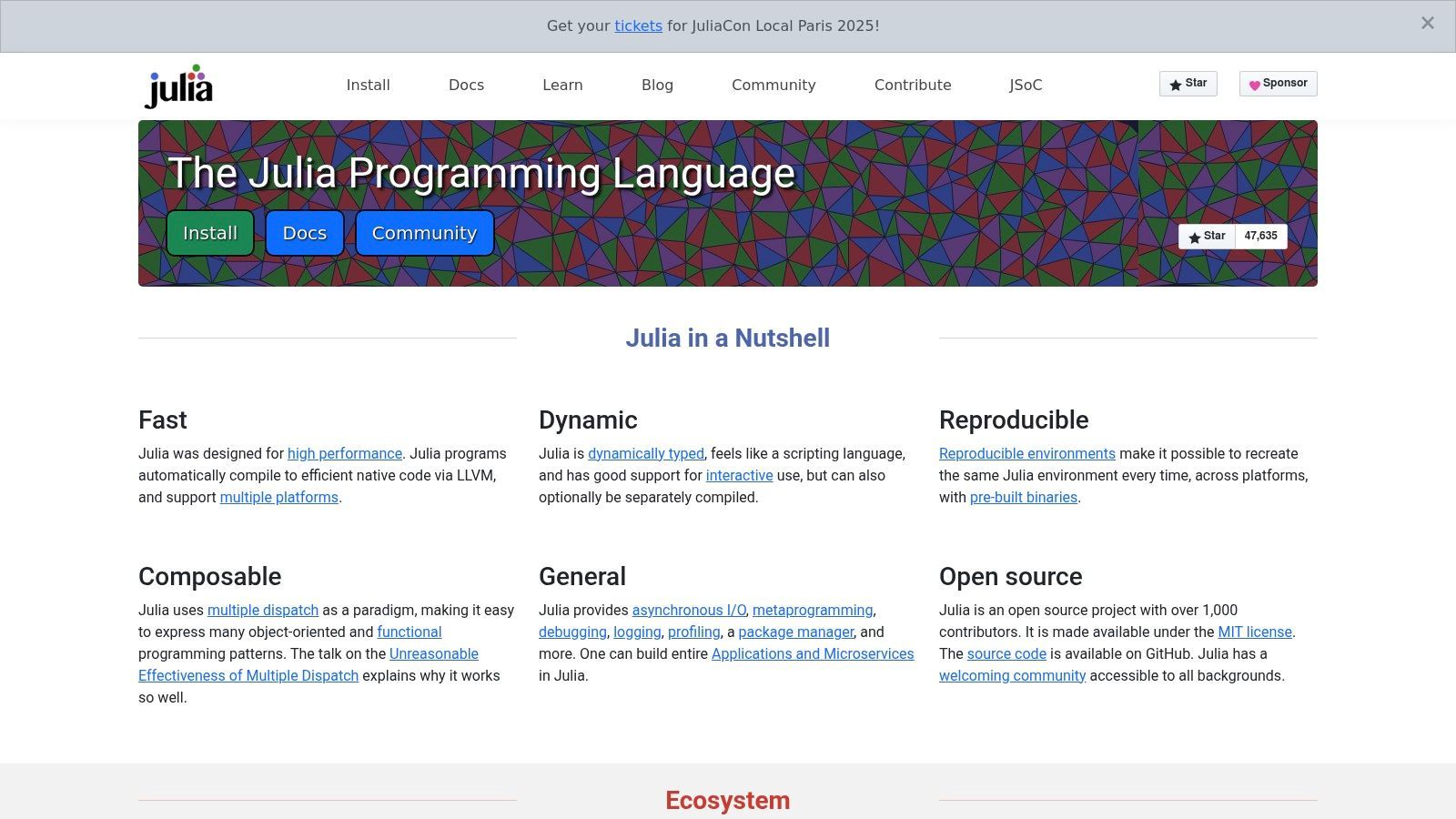
The official headquarters, julialang.org, is your direct portal to this high-octane world. It’s a clean, academic-style site where you can download the latest binaries for free. More than just a download link, it's a comprehensive resource hub with extensive documentation, tutorials, and a package browser that acts as a gateway to its growing ecosystem. The experience is straightforward: get the language, get the knowledge, and start building.
Julia’s secret weapon is its architecture. It uses a just-in-time (JIT) compiler based on LLVM, which translates your readable code into hyper-efficient machine code on the fly. This means you write code that looks like Python but runs nearly as fast as C. Its design philosophy is built around a concept called multiple dispatch, which allows functions to behave differently based on the types of all their arguments, a powerful feature for complex scientific and AI models.
Native Performance: Write your models directly in Julia and get incredible speed without needing to drop down to C or Fortran for bottlenecks. Scientific & ML Ecosystem: Packages like Flux.jl for machine learning, JuMP.jl for mathematical optimization, and DataFrames.jl provide a solid foundation for AI projects. Seamless Interoperability: Need a specific Python library? Julia’s PyCall lets you use Python libraries (like TensorFlow or PyTorch) as if they were native Julia code, bridging the ecosystem gap.
| Pros | Cons |
|---|---|
| Near-C performance; excellent for computationally intensive AI tasks like simulations and large-scale modeling. | Smaller ecosystem; while growing, it has fewer pre-built AI libraries compared to Python. |
| Open source and free; active community and dedicated conferences like JuliaCon foster collaboration. | JIT lag; the first time you run a function, there's a compilation delay, which can slow down initial execution. |
While its ecosystem is still maturing, Julia's raw speed and elegant design make it an unstoppable force in research and high-performance computing. It's the language you choose when every nanosecond counts.
If Python is the world-champion boxer, Anaconda is the entire state-of-the-art training facility, complete with the ring, the equipment, and the coaching staff. It takes the raw power of Python and packages it into a managed, secure, and deployment-ready ecosystem. Anaconda isn't a language itself; it's a supercharged distribution of Python and R, specifically built to eliminate the headaches of environment setup, making it one of the best AI programming languages for teams that need to get to work now.
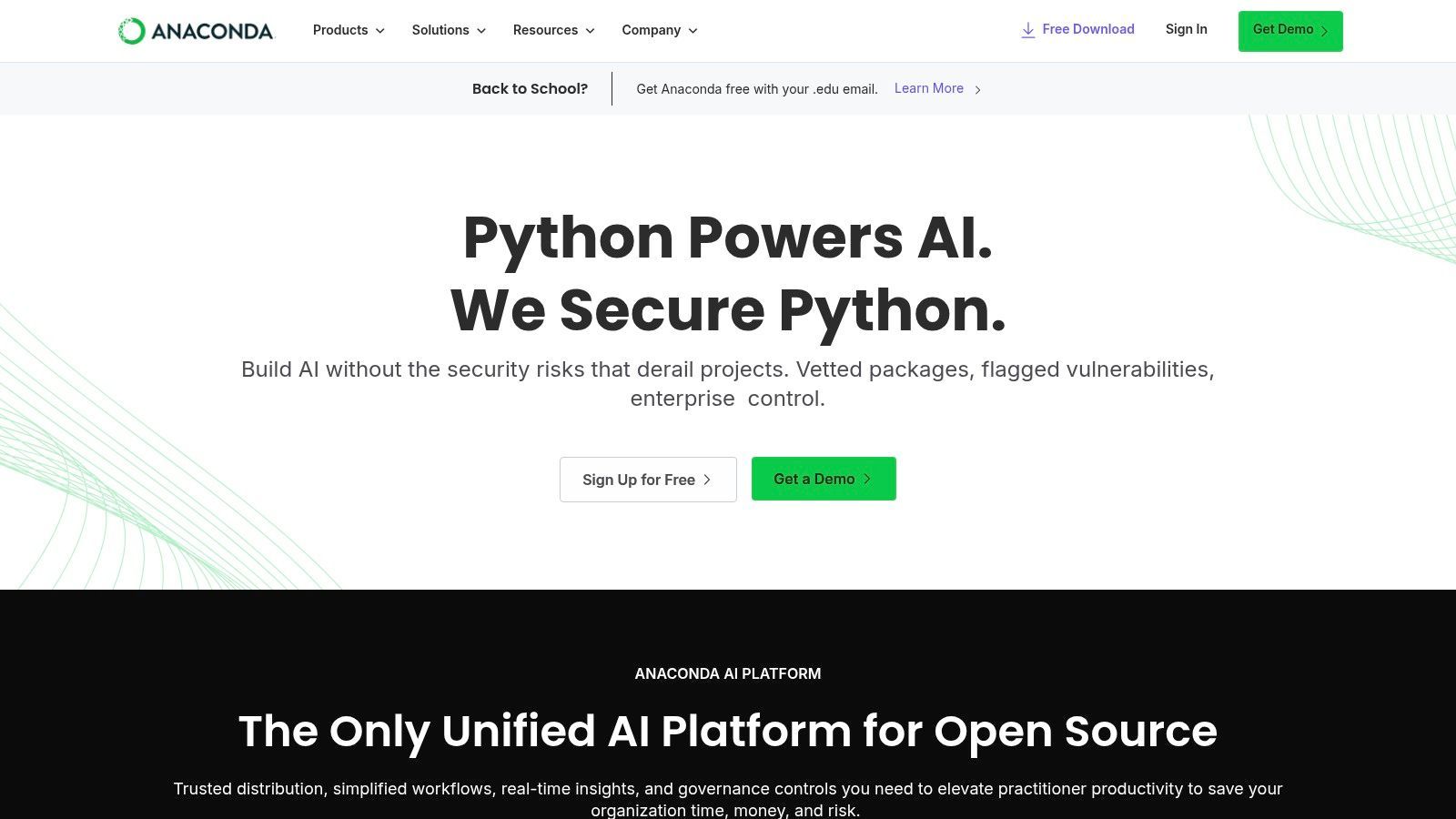
Your journey starts at anaconda.com, where you can download the free Individual Edition. This isn't just a Python installer; it's a massive collection of over 7,500 data science and machine learning packages, all managed by its legendary conda package manager. This platform is designed for those who would rather spend their time building models than fighting with dependency conflicts and compilation errors.
Anaconda's primary advantage is its curated and controlled environment. It solves the "it works on my machine" problem by ensuring that everyone on a team has the exact same set of tools, versions, and dependencies, all pre-vetted for compatibility and security.
Effortless Package Management: The conda tool is a game-changer. It handles package, dependency, and environment management for Python, R, and other languages, isolating projects so they don't interfere with each other.Cloud-Based Workspaces: Anaconda offers Cloud notebooks that come with pre-configured environments, compute resources, and even an AI Assistant to help with code generation and debugging.Enterprise-Grade Security: For businesses, Anaconda provides curated package repositories with security scanning and license compliance, ensuring that your AI projects are built on a secure and legitimate foundation. Many of these features parallel the advancements seen in modern AI tools for content creation, where managed environments streamline creativity.
| Pros | Cons |
|---|---|
| Rapid environment setup; gets you coding in minutes, not hours, with minimal dependency conflicts. | Heavier installation footprint; the base install is much larger than a minimal Python setup. |
| Clear upgrade path from free individual use to advanced business features like SSO and policy filters. | Advanced capabilities require paid subscription tiers for full enterprise-grade security and support. |
While the free version is incredibly powerful for solo practitioners and academics, the real value shines in a team setting. Anaconda provides the guardrails and scalability necessary to take AI projects from a lone developer's laptop to a full-scale enterprise deployment.
If Python is the all-around champion, MATLAB is the specialized, heavyweight contender built for the punishing demands of engineering and scientific research. It's less of a general-purpose language and more of a high-precision instrument. MATLAB's strength lies in its matrix-based environment and professional-grade tooling, making it one of the best AI programming languages for tasks requiring intense numerical computation like signal processing, control systems, and image analysis.
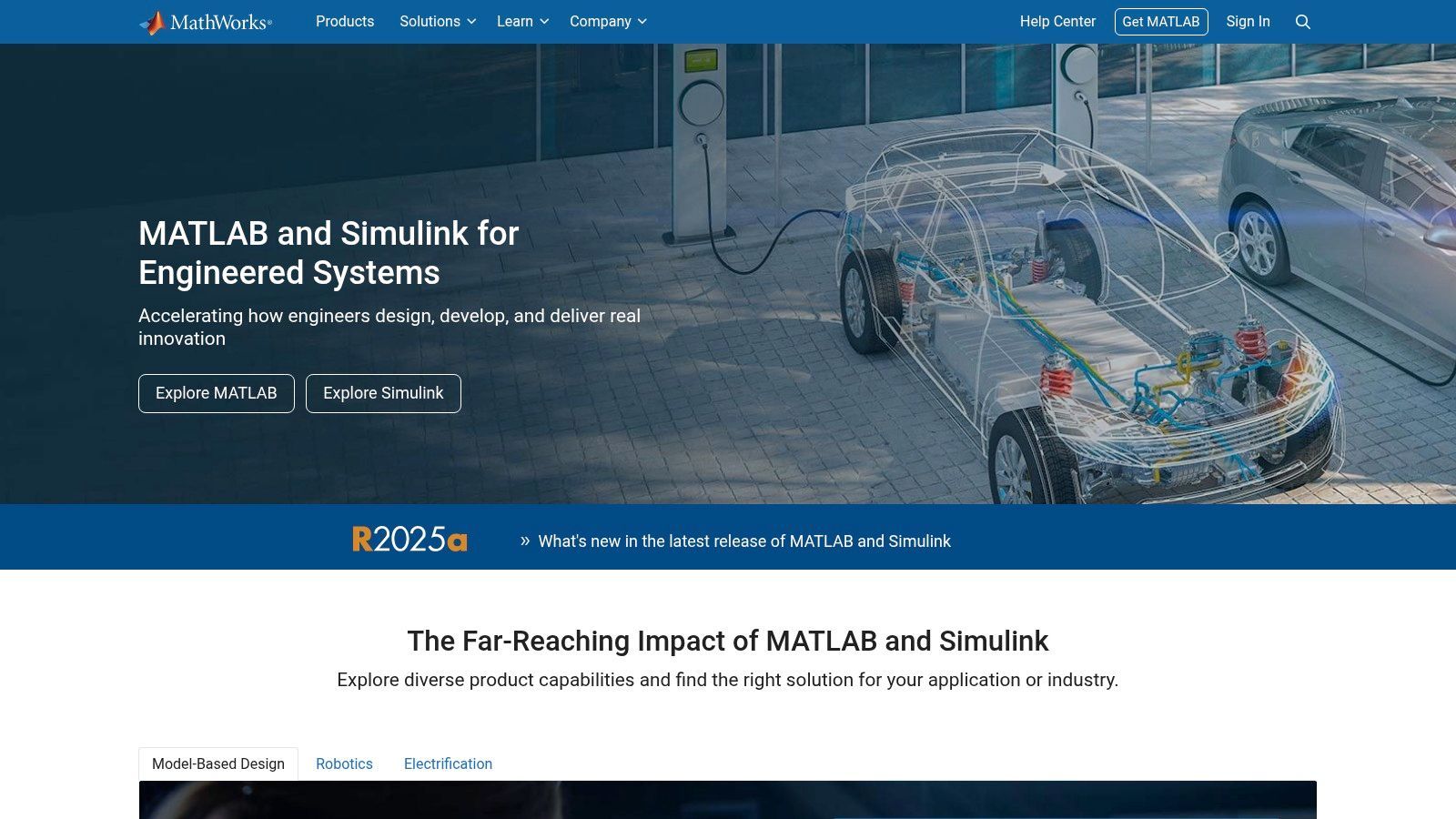
The central hub for all things MATLAB is mathworks.com. Unlike the open-source world, this is a fully commercial ecosystem. The website provides access to named-user licenses, campus-wide deployments for universities, and extensive training materials. It’s a polished, professional portal where you get a complete, integrated solution straight out of the box, backed by dedicated support.
MATLAB shines with its cohesive, end-to-end workflow housed within a rich desktop environment. You aren't just downloading a language; you're getting a fully equipped laboratory. Everything is designed to work together seamlessly, which is a massive advantage in complex engineering projects.
Integrated Toolboxes: The platform offers specialized toolboxes like the Deep Learning Toolbox and Statistics and Machine Learning Toolbox, which provide pre-built functions and apps to accelerate development. Data Labeling and Preparation: Interactive apps like the Signal Labeler and Image Labeler allow you to prepare datasets for AI models without writing extensive code. Hardware Integration: MATLAB excels at deploying models directly to embedded hardware, FPGAs, and GPUs, a critical requirement for robotics, automotive, and aerospace applications.
The platform is designed for professionals and academics who need reliable, verifiable results and don't have time to wrestle with environment configurations or library conflicts.
| Pros | Cons |
|---|---|
| Robust reliability and strong support; trusted in industry and academia with professional backing. | Costly commercial licenses; toolboxes are often licensed separately, increasing the price. |
| Comprehensive end-to-end workflow; from data prep to modeling and deployment in one environment. | Niche focus; less versatile for web-based AI or general software development compared to Python. |
MATLAB's commercial nature is its biggest hurdle for hobbyists, but for organizations where precision, support, and speed-to-market are non-negotiable, it remains an indispensable tool in the AI landscape. It provides a level of integration and reliability that the DIY world can't always match.
If Python is the heavyweight boxer, Wolfram is the brilliant, slightly eccentric scientist who built a battle-mech in their garage. It's not just a language; it's a complete computational intelligence system. The Wolfram Language thrives on a unique blend of symbolic computation, a vast built-in knowledge base, and integrated neural network capabilities, making it one of the best AI programming languages for tasks requiring deep algorithmic and mathematical understanding.
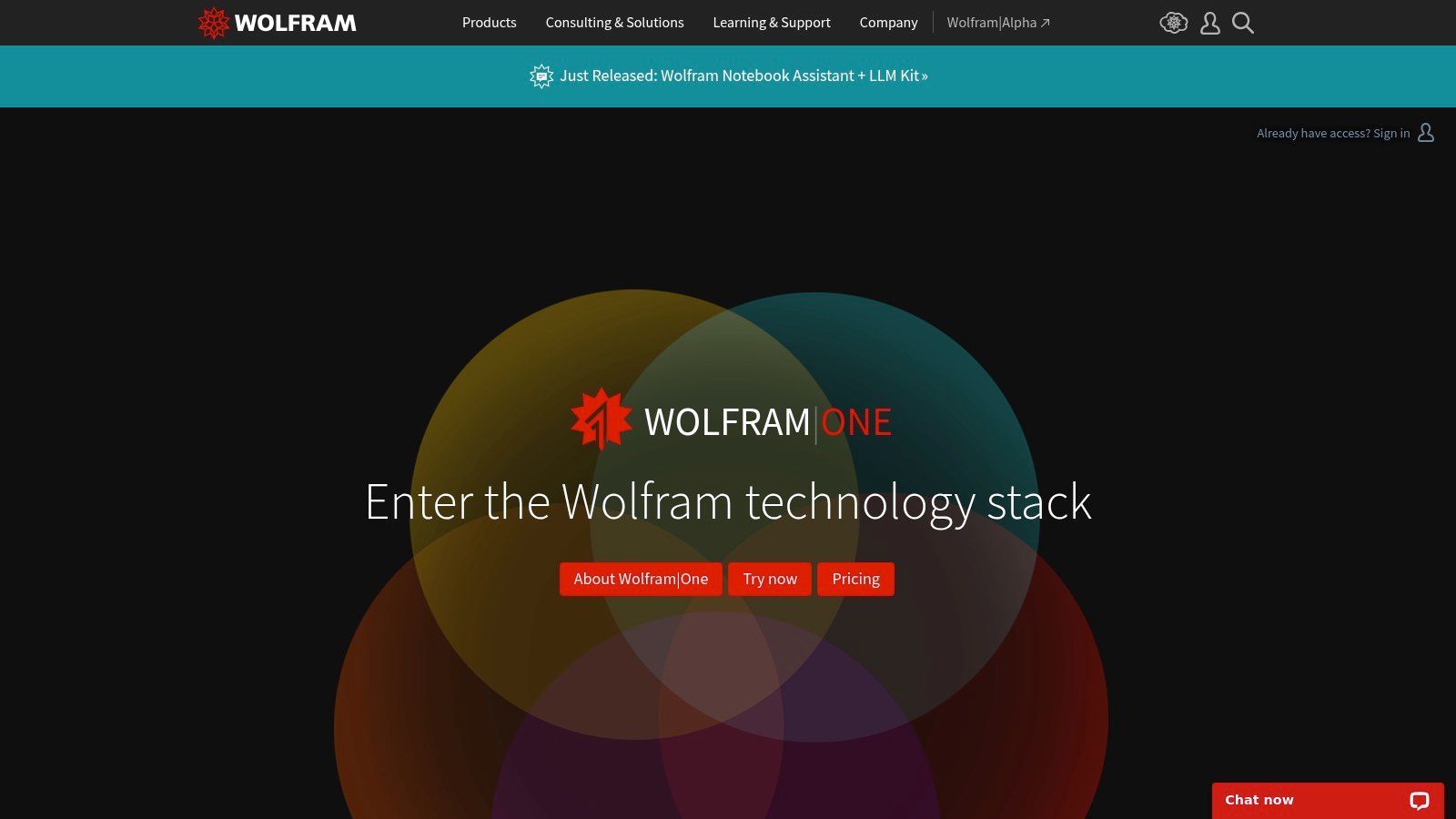
The primary gateway to this ecosystem is Wolfram|One, a subscription-based platform offering a hybrid desktop and cloud environment. Instead of a free-for-all setup, Wolfram provides a curated, all-in-one experience where the tools are pre-integrated. Plans start with a monthly fee and include Wolfram Cloud credits and Wolfram|Alpha API calls, streamlining deployment for smaller projects.
Wolfram's ace in the hole is its "computable knowledge" engine. The language has direct access to the massive, curated dataset that powers Wolfram|Alpha. This allows you to build AI that understands real-world concepts without needing to scrape and clean terabytes of external data first.
Hybrid AI Workflows: Seamlessly combine traditional algorithms, symbolic logic, and neural networks in a single notebook. This is ideal for prototyping complex systems where pure deep learning isn't the whole answer.Integrated Functions: Need to classify an image, find the sentiment of a sentence, or generate a piece of music? There’s likely a built-in function for that, such as ImageIdentify or TextCases.AI-Augmented Tools: Add-ons like the Notebook Assistant and LLM Kit infuse the development environment with generative AI capabilities, helping you code, analyze, and visualize data faster. This integration is so powerful it's also being used to power some of the best AI art generator tools.
| Pros | Cons |
|---|---|
| Powerful symbolic and numeric stack; perfect for algorithmic prototyping and research. | Smaller deep learning ecosystem; fewer third-party libraries compared to Python. |
| Bundled cloud credits and APIs; simplifies setup and deployment for small-scale projects. | Subscription model; access is tied to plans with different feature tiers. |
Wolfram|One is less of a DIY workshop and more of a high-tech, all-inclusive laboratory. While the subscription model and smaller community might be a hurdle for some, its unique ability to fuse knowledge, algorithms, and AI makes it a formidable contender for innovation.
If learning the best AI programming languages is like training for a marathon, Coursera is the elite coaching program that provides a structured, goal-oriented path to the finish line. Instead of just giving you the tools, it offers a full-blown curriculum designed by Ivy League universities and tech giants like Google and IBM. This isn't about aimlessly browsing tutorials; it's about enrolling in a virtual university where you follow a syllabus, complete projects, and earn a certificate that actually holds weight.

The central hub, coursera.org, acts as your campus portal. You can enroll in individual courses, specialize in a specific AI domain, or go all-in with a Coursera Plus subscription for access to a vast catalog. The platform is designed for career-focused learning, blending video lectures with hands-on projects that build a tangible portfolio.
Coursera’s superpower is its structured, project-based pedagogy. It transforms the chaotic process of self-teaching into a clear, step-by-step journey. You're not just learning Python syntax; you're building a neural network from scratch as part of a University of Michigan course. This approach is invaluable for building practical skills.
University-Backed Curriculum: Learn from the same professors who teach on-campus at Stanford, Johns Hopkins, and other top-tier institutions.Industry Certifications: Gain professional certificates directly from companies like Google, IBM, and Meta, which are highly recognized by employers.Specializations: Follow curated learning paths that cover everything from foundational machine learning principles to advanced deep learning and its real-world applications. Exploring how these skills translate to business can be further understood through resources like this guide on AI's role in marketing.
| Pros | Cons |
|---|---|
| Structured, project-oriented learning paths ideal for career development. | Course catalog breadth depends on subscription type; not all content is in every plan. |
| Certificates from renowned universities and industry players like Google and IBM. | Pricing and promotions fluctuate; users need to verify current offers and availability. |
While you have to pay for access, Coursera offers a clear return on investment. It provides the guided structure and credentials that are often missing from purely self-directed learning, making it a top-tier launchpad for a serious career in artificial intelligence.
While not a language itself, Amazon is the sprawling, digital Alexandria where aspiring AI developers go to acquire the sacred texts. Think of it as the ultimate resource depot for learning any of the best AI programming languages. Whether you're a complete beginner needing a gentle introduction to Python or a seasoned data scientist looking for a deep-dive academic paper on Julia’s performance, Amazon is the first and often last stop. It’s the foundational layer of self-education, offering physical and digital tomes on everything from machine learning theory to practical coding cookbooks.

The central hub, Amazon.com, serves as a massive, searchable library. You can find everything from introductory "For Dummies" guides to advanced O'Reilly textbooks with their iconic animal covers. The platform consolidates decades of computer science literature, making it accessible with a few clicks, either delivered to your door or beamed instantly to your Kindle.
Amazon's power isn't just its inventory, it's the ecosystem built around a shopper's journey. It’s a meritocracy of knowledge where the best books rise to the top, guided by the collective wisdom of thousands of readers. It's a key part of the AI ecosystem, much like the AI tools that power modern business strategies. For more insights, check out the best AI tools revolutionizing digital marketing.
Vast Selection: Find learning materials for any AI language, including Python, R, MATLAB, Julia, and even more niche options. The selection covers theoretical foundations, practical guides, and reference manuals. User-Driven Curation: The review and rating system is a powerful tool. You can filter out subpar content by reading detailed feedback from students and professionals who have already vetted the material. Flexible Formats: Choose between physical copies for your bookshelf, Kindle versions for on-the-go learning, or even Audible versions for absorbing concepts during your commute.
| Pros | Cons |
|---|---|
| Broad availability and trusted shipping; get any book delivered quickly, especially with a Prime membership. | Shipping costs; non-Prime members may face shipping fees or minimum purchase requirements. |
| User reviews; easily compare materials and editions based on community feedback to find the best fit. | Household sharing changes; Prime sharing benefits are changing, potentially affecting access for families after October 2025. |
For anyone serious about mastering AI, building a solid library of reference materials is non-negotiable. Amazon provides the most efficient and reliable marketplace to build that foundation, one book at a time.
| Item | Implementation Complexity 🔄 | Resource Requirements ⚡ | Expected Outcomes 📊 | Ideal Use Cases 💡 | Key Advantages ⭐ |
|---|---|---|---|---|---|
| Python.org | Moderate - manual setup of packages and tools | Low - free installers, relies on external packages | High - broad AI/ML applications with mature libs | Beginners to advanced Python AI/ML development | Extensive ecosystem, official source, zero-cost |
| JuliaLang.org | Moderate - some JIT compile wait times | Moderate - high-performance computing resources | Very high - near-C speed for scientific AI tasks | Research environments needing speed and composability | Excellent performance, modern language features |
| Anaconda | Low - curated distributions simplify setup | Moderate - heavier install size, managed environment | High - ready AI/ML setups with fewer conflicts | Users wanting managed, secure Python AI/ML environments | Fast setup, dependency management, cloud notebook |
| MathWorks (MATLAB) | High - commercial software with specialized toolboxes | High - costly licenses, institutional support | High - robust workflows for engineering AI | Engineering, signal processing, academia with budget | Reliable, end-to-end workflows, strong support |
| Wolfram (Wolfram | One) | Moderate - subscription-based with add-ons | Moderate - bundled cloud credits, API access | Moderate - symbolic & numeric AI prototyping | Algorithmic prototyping, hybrid symbolic AI workflows |
| Coursera | Low - structured online courses | Low - subscription or pay-per-course | Variable - depends on learner engagement | Career development and structured AI language learning | Certified programs, project-based learning |
| Amazon | N/A - marketplace for materials | N/A - physical and digital media purchase | N/A - access to knowledge resources | Acquiring AI learning books and study materials | Broad selection, fast US shipping, user reviews |
We’ve journeyed through the wild world of AI development, from Python’s sprawling ecosystem to Julia’s raw speed, and even explored the enterprise-grade powerhouses of Anaconda and MATLAB. The biggest takeaway? The quest for the single "best AI programming language" is a bit of a myth. The real best language is the one that clicks with your project's soul and your team's unique rhythm.
Think of it like choosing an instrument. You wouldn't pick a tuba for a delicate folk song, and you wouldn't bring a ukulele to a symphony orchestra. Your choice depends entirely on the music you want to make.
Before you commit, run through this final mental checklist. It’s the last step before you write that first line of code and unleash your creation.
Project Scope vs. Language Power: Is this a quick-and-dirty data analysis script or a massive, scalable machine learning application? Python is your versatile all-rounder, perfect for rapid prototyping. For projects where every nanosecond counts, Julia’s high-performance DNA might be the game-changer you need. Community and Support: Are you okay with blazing your own trail, or do you need a massive community to back you up? With Python, you’re never more than a Stack Overflow search away from an answer. Newer languages have passionate communities, but the sheer volume of tutorials, libraries, and pre-built models for Python is unmatched. Skill Set and Learning Curve: Be honest about your team’s expertise. Leveraging the Python skills you already have is often smarter than starting from scratch with a new syntax. Platforms like Anaconda streamline the setup process, while learning resources on Coursera can quickly upskill your team for any language you choose.
Key Insight: The "perfect" language doesn't exist. The perfect fit for your specific problem, timeline, and team absolutely does. Your goal is to find that fit, not chase a mythical "best."
Ultimately, the language is just a tool. It's the conduit for your logic, creativity, and problem-solving skills. The true magic isn't in the syntax; it’s in the incredible applications you build with it. Once you've chosen your AI programming language and are ready to apply your skills in a professional setting, you might want to explore remote AI job opportunities to see where your new expertise can take you. Don't just learn a language; master it, build with it, and get ready to create the future.
Ready to see the mind-blowing power of applied AI without writing a single line of code? SendFame uses sophisticated AI to generate personalized celebrity video messages, custom songs, and stunning digital art in seconds. Experience the magic of AI content creation firsthand and create something truly unforgettable at SendFame.
Create Epic
SendFame